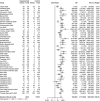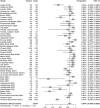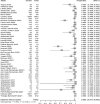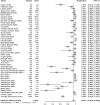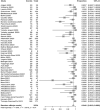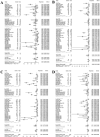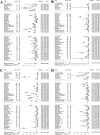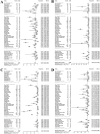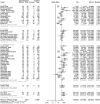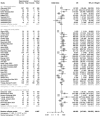The diagnostic accuracy of RT-PCR from self-collected saliva versus nasopharyngeal sampling: A systematic review and meta-analysis
- PMID: 35022280
- PMCID: PMC9280554
- DOI: 10.15537/smj.2022.43.1.20210743
The diagnostic accuracy of RT-PCR from self-collected saliva versus nasopharyngeal sampling: A systematic review and meta-analysis
Abstract
Objectives: To evaluate the diagnostic utility of self-collected saliva in coronavirus desease-19 (COVID-19) screening procedures.
Methods: A total of 6 databases were reviewed from their inception until August 2021. Sensitivity and specificity were measured by extracting items (true-positive, true-negative, false-positive and false-negative) from each paper. We evaluated the diagnostic accuracy based on Quality Assessment of Diagnostic Accuracy Studies, version 2.
Results: A total of 41 studies were included in the final analysis. The diagnostic odds ratio (OR) of self-collected saliva was 196.2022 (95% confidence interval [CI]: 117.8833-326.5546). The area under the summary receiver operating characteristic curve was 0.955. For detecting COVID-19, self-collected saliva had a moderate sensitivity of 0.8476 [0.8045-0.8826] and positive predictive value of 0.9404 [0.9122-0.9599] but high specificity of 0.9817 [0.9707-0.9887] and negative predictive value of 0.9467 [0.9130-0.9678]. In a subgroup analysis, the diagnostic accuracy of self-collected saliva tended to be higher for symptomatic (vs. asymptomatic) examinees.
Conclusion: Although naso/oropharyngeal swab tests are the most accurate and important diagnostic tools, the saliva-based testing method can be used as a suitable alternative test, with the advantages of increased patient convenience, efficient testing, and the need for fewer medical staff and resources. In particular, simple collecting method such as drooling or spitting without coughing would be effective in evaluating the symptomatic patients.PROSPERO no.: CRD42021279287.
Keywords: coronavirus infections; nasopharynx; saliva; specimen handling.
Copyright: © Saudi Medical Journal.
Figures
Similar articles
-
Diagnostic Performance of Self-Collected Saliva Versus Nasopharyngeal Swab for the Molecular Detection of SARS-CoV-2 in the Clinical Setting.Microbiol Spectr. 2021 Dec 22;9(3):e0046821. doi: 10.1128/Spectrum.00468-21. Epub 2021 Nov 3. Microbiol Spectr. 2021. PMID: 34730436 Free PMC article.
-
Diagnostic accuracy of nasopharyngeal swab, nasal swab and saliva swab samples for the detection of SARS-CoV-2 using RT-PCR.Infect Dis (Lond). 2021 Aug;53(8):581-589. doi: 10.1080/23744235.2021.1903550. Epub 2021 Mar 24. Infect Dis (Lond). 2021. PMID: 33760699 Free PMC article.
-
Saliva for molecular detection of SARS-CoV-2 in school-age children.Clin Microbiol Infect. 2021 Sep;27(9):1330-1335. doi: 10.1016/j.cmi.2021.02.009. Epub 2021 Feb 19. Clin Microbiol Infect. 2021. PMID: 33618013 Free PMC article.
-
SARS-CoV-2 saliva testing using RT-PCR: a systematic review.Int J Infect Dis. 2022 Aug;121:166-171. doi: 10.1016/j.ijid.2022.05.008. Epub 2022 May 13. Int J Infect Dis. 2022. PMID: 35577250 Free PMC article.
-
Diagnosis of SARS-CoV-2 by RT-PCR Using Different Sample Sources: Review of the Literature.Ear Nose Throat J. 2021 Apr;100(2_suppl):131S-138S. doi: 10.1177/0145561320953231. Epub 2020 Aug 31. Ear Nose Throat J. 2021. PMID: 32865458 Free PMC article. Review.
Cited by
-
Influenza A, like Omicron SARS-CoV-2, Is Similarly Detected in Saliva or Nasopharyngeal Samples via RT-qPCR.Viruses. 2023 Nov 30;15(12):2352. doi: 10.3390/v15122352. Viruses. 2023. PMID: 38140593 Free PMC article.
-
Salivary SARS-CoV-2 RNA for diagnosis of COVID-19 patients: a systematic revisew and meta-analysis of diagnostic accuracy.Jpn Dent Sci Rev. 2023 Jun 21;59:219-38. doi: 10.1016/j.jdsr.2023.06.004. Online ahead of print. Jpn Dent Sci Rev. 2023. PMID: 37360001 Free PMC article. Review.
-
Saliva Diagnostics in Spaceflight Virology Studies-A Review.Viruses. 2024 Dec 12;16(12):1909. doi: 10.3390/v16121909. Viruses. 2024. PMID: 39772216 Free PMC article. Review.
References
Publication types
MeSH terms
LinkOut - more resources
Full Text Sources
Medical


